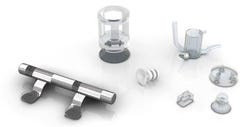Switzerland's watchmaking pedigree has transferred remarkably well to the production of medical device components. The technology transfer was borne of necessity in the 1970s, when electronic wristwatches began to flood the market, and Swiss industry entered crisis mode. The demand for precision engineered components meeting tight tolerances in the medical technology sector matched the capabilities of the country's manufacturing landscape and highly skilled workforce--the start of a beautiful relationship.
January 4, 2014
Switzerland's watchmaking pedigree has transferred remarkably well to the production of medical device components. The technology transfer was borne of necessity in the 1970s, when electronic wristwatches began to flood the market, and Swiss industry entered crisis mode. The demand for precision engineered components meeting tight tolerances in the medical technology sector matched the capabilities of the country's manufacturing landscape and highly skilled workforce--the start of a beautiful relationship. Today, more than 800 manufacturers are active in the medical technology arena, according to Switzerland's Medical Cluster. Trelleborg Sealing Solutions (Stein-am-Rhein, Switzerland), a business unit of the Trelleborg Group that provides liquid silicone rubber (LSR) injection molding for the life science and other sectors, is among them. It recently highlighted some manufacturing milestones in a press release.
 One design challenge cited by Trelleborg involved a valve used in a hospital sterilization system. The component had a thermoplastic body sealed with an O ring, and the assembly included dead space where bacteria could thrive. Using nonlinear finite element analysis, the company rectified the design flaw by applying a two-shot LSR process. The thermoplastic is injected in a closed-loop automated system followed by the LSR to produce the composite, explains Ursula Nollenberger, LSR Product Line Director. A single sealing component was created to close the gap in the assembly. "The two-component system demands the highest level of tool precision," says Nollenberger, "but avoids the need for a second assembly step."
One design challenge cited by Trelleborg involved a valve used in a hospital sterilization system. The component had a thermoplastic body sealed with an O ring, and the assembly included dead space where bacteria could thrive. Using nonlinear finite element analysis, the company rectified the design flaw by applying a two-shot LSR process. The thermoplastic is injected in a closed-loop automated system followed by the LSR to produce the composite, explains Ursula Nollenberger, LSR Product Line Director. A single sealing component was created to close the gap in the assembly. "The two-component system demands the highest level of tool precision," says Nollenberger, "but avoids the need for a second assembly step."
The product is currently being validated, and production of several million parts annually is expected to begin later this year.
The company also helped to develop an O ring for a new inhaler marketed by pharmaceuticals company Boehringer Ingelheim. The component, which seals the dosing chamber, must be fabricated to a tolerance of ±1mm³, and flash at the mold split must be less than 0.5 mm, says Trelleborg. It is able to achieve these results thanks to in-house expertise in design, manufacturing, and materials, says Nollenberger. That, and a tradition of dealing with tiny, complex parts that is in the DNA of Swiss manufacturers.
About the Author(s)
You May Also Like




